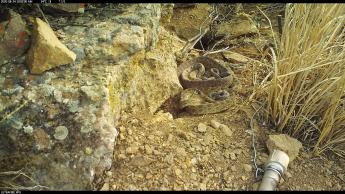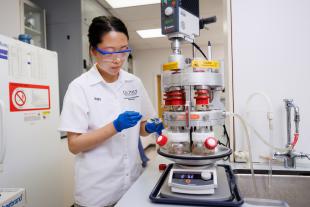Want to Enter a Rattlesnake Den? These Researchers Need Your Help — Don't Worry, It's Remote

A multi-university team that includes Cal Poly researchers today launched a community science project that seeks to understand rattlesnake behavior by using cameras to view the snakes in their natural habitat.
Project RattleCam, which is hosted on the Zooniverse community science website, gives members of the public the chance to analyze thousands of time-lapse images taken at rattlesnake dens near Steamboat Springs, Colorado.
Members of the public can register for a free Zooniverse account and immediately begin assisting with research by answering questions about the photos, including counting the number of adult and baby snakes in each photo, identifying predators, and more.
“Community science is a way of bringing the process of discovery to people from all walks of life, improving the accessibility of science,” said Emily Taylor, Cal Poly biology professor, project co-lead, and a nationally recognized expert on reptiles and amphibians. “We are really excited to work with community scientists to discover the secrets of rattlesnake behavior. There’s so much we don’t know yet about these fascinating creatures.”
Scientists estimate that the den of prairie rattlesnakes, located on a private ranch, has at least 1,500 snakes. The photos will allow researchers to: characterize rattlesnake maternal care; learn how they obtain water in this extremely dry habitat; examine whether the rattlesnakes preferentially spend time with certain individuals (a behavior similar to humans having friends); and determine which predators eat the rattlesnakes.
“So many rattlesnakes in one place is a scientist’s dream come true, because we can more easily collect data and, in this case, spy on large aggregations of the snakes to learn about rarely seen social behavior such as mother rattlesnakes caring for their newborn pups,” said Scott Boback, a biology professor at Dickinson College, who co-leads the project with Taylor.
Often portrayed as vicious and scary, rattlesnakes are actually secretive creatures that do not want to bite people. Project RattleCam allows people to see the rattlesnakes behaving naturally, in a virtual setting.
“If people could just see the rattlesnakes in person, they would realize how gentle they are — and people might not be so likely to kill rattlesnakes,” said Taylor.
In the future, the research team will add cameras that livestream to YouTube.
“Soon you all can tune in to watch rattlesnakes sunning themselves live from your own desk,” Taylor said.




